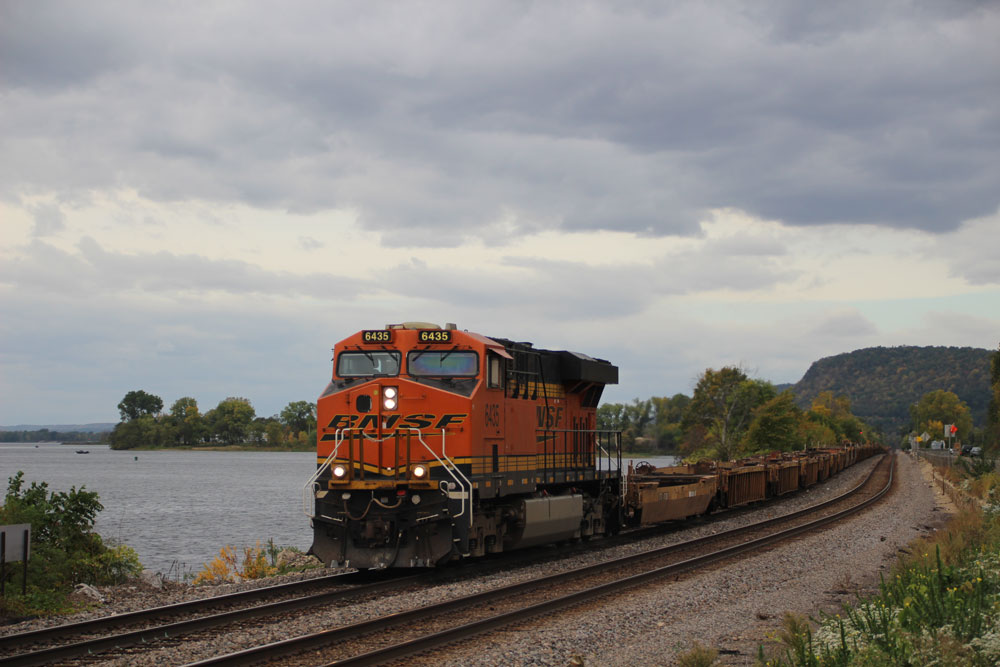
Intermodal is having a moment in the sun thanks to the impact of the pandemic. Consumers are buying goods faster than retailers can refill their shelves and warehouses, so imports are surging and ports are clogged. Parcel shipments are soaring as a decade’s worth of e-commerce growth was crammed into the past year. U.S. intermodal volume set a record for January through May, and railroads have struggled to handle the onslaught of containers and trailers.
This is a good problem to have. But sooner or later things will settle into a new normal. What then? Intermodal growth was slowing before volume peaked in 2018. The U.S. Class I systems have pruned interline service since then, dropping steel-wheel connections between hundreds of city pairs in the name of simplicity.
Today’s North American intermodal network is all spine and no ribs, as intermodal analyst Larry Gross likes to say. In fact, three-quarters of all intermodal traffic moves in just 10 lanes, with Los Angeles and New Jersey to Chicago by far the busiest. So, where can railroads turn to put meat on the bones of the intermodal network?
Intermodal veteran Ted Prince — who is equal parts intermodal visionary, champion, and critic — is brimming with ideas. The easy business has already migrated to the railroads, he says, but intermodal’s potential is far greater than what moves on rails today.
One new market to tap, Prince says, is connecting cities that are within roughly 500 miles of the Mississippi River. This so-called watershed traffic sits in an intermodal no man’s land between the big Eastern and Western railroads. Aside from Norfolk Southern service here and there — Detroit-Kansas City RoadRailers, Dallas-Atlanta via the Meridian Speedway, and Kansas City to Louisville, Ky., and Atlanta — intermodal doesn’t link cities within the watershed.
Separated by roughly 875 miles, “tweener” points like Minneapolis and Pittsburgh are a decent length of haul for one railroad, but not for two. And then there’s the problem of getting loads through Chicago, where steel-wheel interchange is limited and crosstown rubber-tire moves are an expensive complication.
Prince’s solution is to build small intermodal sorting hubs outside key gateways like Chicago and Memphis. These terminals would build traffic density through efficient steel-wheel interchange and lift containers between trains to create blocks bound for common destinations. “One or two of those could just astronomically catapult volume into new lanes,” Prince says. “To grow the business we’re going to have to be in new lanes. And new lanes require a new way of looking at the network and much more cooperation and coordination.”
CSX Transportation thought it had built a better mousetrap with the intermodal sorting center it opened in North Baltimore, Ohio, a decade ago. The terminal put the hub in CSX’s hub-and-spoke intermodal network, which allowed the railroad to serve smaller markets. But under new CEO E. Hunter Harrison, CSX in 2017 scuttled hub-and-spoke in favor of a lower cost, more profitable, and more reliable point-to-point intermodal network connecting big markets.
The problem with North Baltimore was not necessarily the sorting hub concept but the way CSX ran it. Boxes might be handled five times, rather than simply lifted from one train to another. And how long each container spent in the terminal was a mystery because it was not tracked.
Intermodal sorting hubs do work in Europe. I always hesitate to bring up European examples since the railroad economics are so different. But just north of Milan, Hupac’s Terminal Busto Arsizio-Gallarate handles dozens of intermodal train pairs per day and sorts traffic moving between points in Italy and a half-dozen countries. Substitute Dallas-Detroit, Omaha-Columbus, or Houston-Jacksonville for Rome-Rotterdam and you get the idea.

Building a sorting hub or two – whether financed by an infrastructure fund, Chicago’s CREATE, or the railroads themselves – does not get you past the short-haul issue. And Prince admits there’s no obvious catalyst for railroads to suddenly cooperate, share revenue, and embrace an intermodal mentality based on something other than the 12,000-foot stack train.
But if growth is a goal what’s the alternative? Coal is dying. Most carload commodities are declining. So that leaves intermodal as the industry’s growth engine. There’s plenty of potential domestic intermodal business in the watershed, Prince says, and the critical mass to make it work. “There’s nothing holding railroads back but fear,” Prince says. “And I would say that there’s a lot of fear of Wall Street.”
You can reach Bill Stephens at bybillstephens@gmail.com and follow him on Twitter @bybillstephens













It is bizarre to me how dozens of Class I’s could handle passenger service in an almost seamless fashion (see the California Zephyr on three, or numerous Florida trains on 3 or 4), but they can’t figure out how to exchange power and crews in Chicago (or St. Louis, or Memphis, or New Orleans) to expedite a stack train. Is Class I management truly that inept?
BNSF with their haulage agreement to CSX Northwest Ohio could, in theory, offer a single carrier product from St. Paul and Kansas City to Ohio. I’m not aware of them offering those lanes.
Oh sure, the BNSF could do that. But they’d have to know things such as how much revenue was available.
That would be the marketing department’s job. To identify, quantify, and evaluate the business potential.
The railroads just don’t have marketing departments that can do such things. It’s a major shortcoming. Such analysis is readily possible. They just haven’t developed the ability.
It’s a much deeper problem.
Marketing in general and market development specifically are glaring, significant weak points for the railroads. They just don’t have the ability to do those things.
The eastern/western railroad divide is a problem. But the “Watershed” area also originates significant business headed for the west coast population centers and export. This would be long haul, high volume, single railroad traffic. The BNSF and UP run right past the concentrated origins every day. No one at either company seems to have a clue as to how to get this business on their railroad.
Heck Fire, Tyson alone originates around 300 loads per week out of the Sioux City area for the west coast. Yes, it’s red meat and requires it refrigerated transport. The railroads can do that. They do it every day. There are other protein companies in the “Watershed”. And there are other food products headed for the west coast in large volumes. (Eggs, chicken, cereal, etc.) Backhaul is not a problem for reefer equipment from the west coast.
Anyone in Omaha or Ft. Worth who would even suggest analyzing placing an intermodal terminal in Sioux City would be quickly slapped down with people lining up to explain why it couldn’t possibly work.
The railroads just plain suck at marketing and market development.
Yup, I agree. Suppose everything merges. Suppose we had one railroad from Prince George to Veracruz, Los Angeles to Halifax, Edmonton to Houston, Seattle to Miami. You’d have the exact same problems. If two or three railroads can’t interline a box, neither can one merged railroad handle a box.
All of you who think another merger round will solve anything, plz. explain how the last several rounds of mergers has resulted in no increase in market share. When there were thirty or forty big railroads instead of seven big railroads, rail had a much bigger market share than now.
I have no doubt that there is business to be found here, but I don’t see how you blend something that does not fit well with a large train size world. In a more open marketplace a firm could purchase corridor and terminal capacity from various roads and put together their own product.
They might use terminal capacity from Class 1s at the MSP/KC/PIT/DET/COL/CIN ends of the network, then use an underutilized facility like Rockwell Yard on the BRC at their Chicago hub, perhaps with a small ramp and then build a hub that works eastbound traffic part of the day and westbound the other part. If the Class 1s are being compensated at market rates for the capacity and don’t want to market a competing product, then what do they have to lose?
I don’t think anything is more telling of this scenario than how much a prime location for a hub-and-spoke system like Harrisburg has been mismanaged under NS and TOP21. The ability to “tap” was there, and we willingly got rid of it.
Some facts:
-The Crescent Corridor is dead.
-NJ-CHI may be the busiest lane but I think we’re down to 3 interline moves total now, from 6. There is no eastbound train directly off UP in this lane.
-Every major metro area and port within Harrisburg’s reach now gets serviced like a backwoods outpost would have in the 1800’s, one very large, very slow “supply train” that carries everything. Not just all intermodal – all freight, autos, MOW equipment, EVERYTHING. Most don’t originate at the intermodal pads, either so actually getting intermodal onto connecting trains is even more difficult.
-A UPS mail train was delayed to switch a customer while on the Northeast Corridor.
-We’d rather swap blocks in Sandusky, on some annex tracks of the coal docks, which offers nothing in terms of location or accessibility that Harrisburg does.
How is Indiana railroad doing with it’s Chicago to Indianapolis run? I know at one time it was very successful.
One transcontinental merger would force a second, and the STB would take forever to approve either one. Particularly because the STB took a lot of criticism for the UP-SP and CSX/NSC-Conrail mergers, both of which led to service problems which led to shippers complaining to their congressmen. The Santa Fe for years had successful run throughs at Avard with the Frisco and at Streator with Conrail (incidentally for the purpose of avoiding Chicago). Too many rail executives now are only focused on the operating ratio to the exclusion of running a successful customer oriented business.
Prince is correct in his analysis. True transcontinental mergers would solve the short haul problem handily. Interline cooperation is a limited fix at best.
Railroads managed to interline loads when there were dozens – not seven – Class I railroads, before there were computers and the Internet and e-mail.
Charles, also a time when freight was regulated and it was piggybacks when their was dozens. I do agree as you noted that their is a lot that current Class I’s can do in this day and age of communication for which they can’t seem to grasp the idea or simply don’t want to be a logistics company when those who want their products already work within the realm of logistics, they don’t care if their products are on a ship, train, tuck, plane at any given moment as long as they know the cost, location and timeline
However, in same breadth. I would argue that having two true west to east coast transcontinentals railroads in the US instead of four meeting in the middle would be huge step. Why not? or maybe better way to put. Why would UPS ever want to land its plane from west coast in Memphis to hand over its package to FedEX to get to east coast. Yes, not a true apple to apple comparison but I’m surprised at end of day that BNSF as privately held company hasn’t been more aggressive to get its hands on CSX or NS.
First railroads need mergers to open up these new lanes. Two how do you handle such service? TOFC? COFC? Combination? Railroads much prefer double stack economics. PSR’s provision for block swapping should play a role here.
No railroads don’t need mergers. They need to grow brains work together. I see merchandise trains from Elkhart (Norfolk Southern) to Cicero (BNSF) all the time. No one rubber-wheels merchandise loads. But in two generations of intermodal, railroads can’t figure out how to get containers around Chicago? I call nonsense.